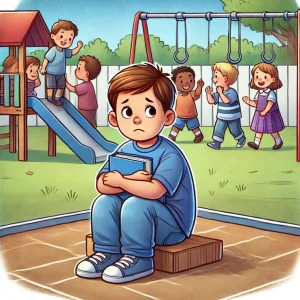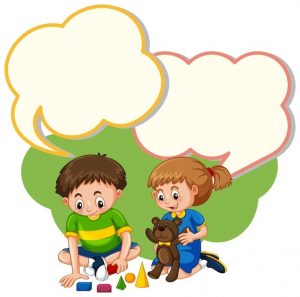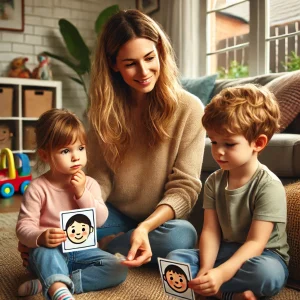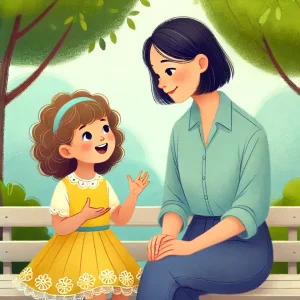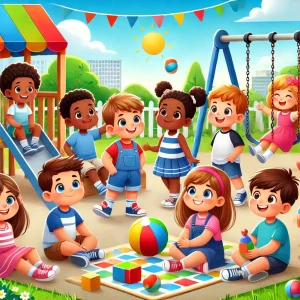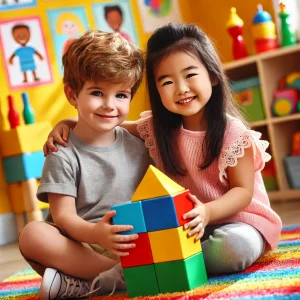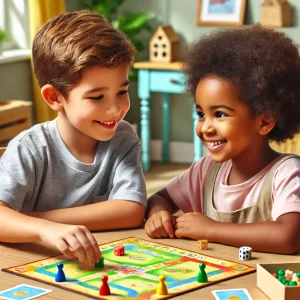Helping Kids with Autism and ADHD Through Social Stories
Last Updated: January 21, 2025
Social stories are specially crafted narratives designed to help children with autism and ADHD grasp social cues and appropriate behaviors through simple, relatable examples. These tools break down complex situations into manageable steps, fostering understanding, empathy, and essential life skills. By illustrating everyday scenarios—like preparing for school or a doctor’s visit—social stories empower neurodivergent kids to navigate their world more confidently and effectively. Let’s delve into how these stories can be transformative in building real-world skills for children who experience the world differently.
Struggling to explain daily routines to your child? Download these Social Stories tailored for kids with ADHD and Autism and make communication easier! – Get the Stories Now
How Social Stories Help Kids with Autism and ADHD
Social stories simplify complex situations, making daily interactions more manageable for kids with autism and ADHD. Here’s how they help:
- Teaching Social Cues: For children struggling to pick up on social nuances, social stories can illustrate how to make friends or share toys, showing step-by-step interactions like using eye contact or waiting for a turn.
- Emotional Regulation: Social stories help manage emotions by preparing kids for new experiences, like visiting a doctor, by explaining what to expect and how to cope with anxiety.
- Managing Routines: They also aid in understanding daily routines, which can be challenging for these children. For example, a story might walk through a school morning, helping them anticipate and prepare for the day ahead.
Key Benefits of Social Stories
Social stories offer significant benefits for children with Autism and ADHD, helping them navigate a world that can often seem unpredictable and overwhelming. Here’s a closer look at how these stories make a difference:
For Kids with Autism:
- Reducing Anxiety: By detailing what to expect in various social situations, social stories help minimize the anxiety that comes from unknown or misunderstood scenarios. Dr. Carol Gray, the developer of social stories, notes that these narratives allow children to practice and prepare mentally for interactions, reducing stress and increasing comfort.
- Improving Predictability: Regular use of social stories can make daily transitions and activities more predictable, thereby enhancing a child’s ability to cope with the regular changes in their environment.
- Teaching Perspective-Taking: Social stories enhance understanding of others’ thoughts and feelings, which is often a challenge for children with autism. This not only improves empathy but also aids in social integration.
For Kids with ADHD:
- Enhancing Focus: By breaking down information into small, manageable parts, social stories help children with ADHD maintain focus, a task that can otherwise be daunting due to their tendency to be easily distracted.
- Managing Impulsivity: These stories teach the consequences of actions in a clear, narrative form, helping children understand why it’s important to think before acting.
- Building Patience: Through repeated exposure to scenarios that require waiting or taking turns, social stories can help develop patience, an essential skill for children with ADHD who often seek immediate gratification.
Expert Insight: According to Dr. Elizabeth Laugeson, an expert in ADHD and autism therapies, “Social stories are not just about teaching social skills. They are about providing a framework for understanding social behavior that empowers children with the confidence to engage with their peers.”
When and How to Use Social Stories
Social stories are most effective when used at the right time and in the right way. Here are some practical tips to get the best out of these valuable tools:
When to Use Social Stories
- Before New Experiences: Social stories are excellent for preparing children for unfamiliar situations, such as visiting the dentist, attending a birthday party, or starting a new school year.
- During Transitions: Whether it’s transitioning from playtime to bedtime or moving to a new home, social stories provide step-by-step guidance to ease these changes.
- In Teaching Moments: Use them to address specific challenges like waiting in line, sharing toys, or managing frustration in real-time or as a follow-up.
How to Integrate Social Stories into Daily Routine
- Start the Day with a Story: Use a story about morning routines to set the tone for the day, helping children know what to expect.
- Reinforce with Visuals: Pair the story with pictures, symbols, or illustrations to make it easier for the child to connect with the content.
- Use Consistently: Incorporate stories into daily or weekly routines to build familiarity and understanding over time.
- Make It Interactive: Involve the child by asking questions or encouraging them to act out parts of the story to reinforce learning.
Example: Morning Routine Social Story
| Step | What the Story Explains |
|---|---|
| Wake Up | “It’s time to wake up and start the day!” |
| Brush Teeth | “We brush our teeth to keep them clean.” |
| Get Dressed | “Choose your favorite shirt and pants.” |
| Eat Breakfast | “Breakfast gives us energy to learn and play.” |
Simplify challenging situations like bedtime or sharing. Download our Social Stories to help your child with Autism and ADHD navigate life confidently – Download Here
Creating Effective Social Stories
Crafting an effective social story is easier than you might think. The key is to keep it simple, engaging, and relevant to your child’s needs. Follow this step-by-step guide to create a social story that truly resonates:
Step-by-Step Guide to Creating a Social Story
- Start with a Clear Goal or Situation
Identify the specific situation or skill you want the child to learn.
Example: Preparing for a dentist visit or learning to share toys. - Use Simple, Positive Language
Write in short, straightforward sentences that focus on what the child can do rather than what they shouldn’t.
Example: “We take turns when playing with toys” instead of “Don’t grab toys.” - Incorporate Visual Aids
Include pictures, illustrations, or symbols to make the story more engaging and easier to understand.
Tip: Use photos of the child or familiar settings for a personal touch. - Keep It Short and Focused
Limit each story to a single topic or scenario. Break larger concepts into multiple stories if needed. - Personalize the Story
Tailor the story to the child’s preferences and needs. Mention their name and use examples they can relate to. - Use Templates or Online Tools
Save time by using customizable templates or apps designed for creating social stories.
Wellness Hub offers a range of tools to help parents and educators design stories that align with their child’s unique learning style.
Examples of Social Stories for Everyday Scenarios
Social stories can turn everyday challenges into teachable moments for kids with autism and ADHD. Here are some practical examples of social stories that can help children learn important life skills:
1. Getting Ready for School
This social story can guide a child through their morning routine:
- Page 1: “I wake up in the morning and get out of bed.”
(Picture of a child happily waking up) - Page 2: “I brush my teeth to keep them clean and healthy.”
(Visual of a toothbrush and toothpaste) - Page 3: “I get dressed and pack my school bag.”
(Image of a backpack being packed) - Page 4: “Now I am ready for school, and I feel proud!”
(Photo of a child ready to leave)
2. Sharing Toys with Friends
Teach the importance of sharing and turn-taking:
- Page 1: “When I play with my friends, we share toys.”
(Picture of two kids playing together) - Page 2: “Taking turns makes everyone happy.”
(Illustration of children smiling while playing) - Page 3: “If I feel upset, I can tell my friend how I feel.”
(Visual of a child speaking to a friend)
3. Going to the Dentist
Ease anxiety with a step-by-step guide:
- Page 1: “I visit the dentist to keep my teeth strong and clean.”
(Image of a dentist office) - Page 2: “The dentist will count my teeth with a small mirror.”
(Photo of a dental tool) - Page 3: “I can take deep breaths if I feel nervous.”
(Illustration of breathing exercises) - Page 4: “After the visit, I feel proud of myself!”
(Picture of a child with a sticker)
4. Dealing with Frustration or Waiting in Line
Help with managing emotions and patience:
- Page 1: “Sometimes I have to wait for my turn.”
(Picture of a line at the store) - Page 2: “If I feel frustrated, I can take three deep breaths.”
(Illustration of a breathing technique) - Page 3: “When it’s my turn, I feel happy and calm.”
(Visual of a smiling child reaching the front of the line)
Incorporating Social Stories Into Play and Learning
Social stories don’t have to stay on paper—they can come to life through play and interactive activities! Combining social stories with sensory play and role-playing can make them more engaging and impactful for kids with autism and ADHD.
1. Combine Social Stories with Sensory Play
Sensory activities can reinforce the lessons in social stories by engaging multiple senses. Here’s how:
- Story about Sharing Toys: After reading, use a sensory bin filled with toys. Practice taking turns with the toys in the bin, following the story’s steps.
- Story about Managing Emotions: Pair it with a calming sensory activity like playing with slime or kinetic sand, which helps children practice soothing techniques.
- Why It Works: Sensory play helps children connect emotionally and physically with the story, making lessons stick.
2. Use Interactive Games to Reinforce Learning
Turning social stories into games can make learning fun and less intimidating:
- Scenario Matching: Create cards with scenarios from the story (e.g., “Waiting for your turn”). Have the child match the correct response (e.g., “Take deep breaths”).
- Action Challenges: After reading a story, create challenges like “Pretend to brush your teeth” or “Practice greeting a friend.”
- Why It Works: Games make social learning feel more like play, which is especially helpful for kids with ADHD who thrive in active, hands-on environments.
3. Encourage Role-Playing with Family or Peers
Role-playing brings social stories to life in a safe and supportive setting:
- Practice New Skills: Act out the story of visiting a dentist, with one person playing the child and another playing the dentist. Switch roles to deepen understanding.
- Build Confidence: Role-playing scenarios like “Making a Friend” can help children rehearse before real-life situations.
- Why It Works: Role-playing encourages children to apply what they’ve learned, helping them feel more prepared for real-world interactions.
The Bigger Picture: Empowering Neurodivergent Kids
Social stories do more than teach everyday skills—they help children with autism and ADHD gain independence and confidence. These simple tools give kids the knowledge and practice they need to handle real-life situations.
How Social Stories Help
- Building Independence: By breaking tasks into small, clear steps, social stories make it easier for kids to learn and repeat actions on their own.
Example: A child can use a social story to learn how to get ready for school and eventually do it without help. - Boosting Confidence: When kids understand what to expect, they feel less anxious and more capable.
Example: A social story about saying hello can encourage a child to start conversations with new people.
Consistency and Patience Matter
- Stay Consistent: Using social stories regularly helps reinforce lessons. For example, a nightly bedtime story can make the routine smoother over time.
- Be Patient: Every child learns at their own pace. Small wins, like waiting in line or greeting someone, show meaningful progress.
Discover how online speech therapy can help your child. Book your free consultation today! – Book Your Free Consultation
Conclusion
Social stories are amazing tools that help kids with autism and ADHD grow in confidence, learn life skills, and handle challenges better. By making situations easy to understand, these stories teach independence and build self-esteem over time. At Wellness Hub, we offer easy-to-use social story templates and tools to help parents and educators make learning fun and engaging. From managing routines to handling emotions, our resources are here to support you.
Frequently Asked Questions:
1. What are social stories for kids with autism and ADHD?
Social stories are short, simple narratives that help kids with autism and ADHD understand social situations, learn life skills, and manage emotions by breaking tasks into easy-to-follow steps.
2. How do social stories help children with autism?
Social stories reduce anxiety, teach social cues, and help children with autism navigate new or challenging situations, like visiting the doctor or making friends.
3. Can social stories help kids with ADHD focus better?
Yes, social stories help kids with ADHD by simplifying routines, teaching patience, and guiding them to manage impulsivity in daily activities.
4. When should I use social stories for my child?
Use social stories before new experiences, during transitions, or to address specific challenges like waiting in line or sharing toys.
5. How do I write a social story for my child?
Start with a clear goal, use positive and simple language, add pictures or illustrations, and keep the story short and focused. Tools like Wellness Hub can help you create custom stories.
6. What are some examples of social stories?
Examples include getting ready for school, going to the dentist, sharing toys, or dealing with frustration in a calm way.
7. Can I use social stories to teach routines at home?
Absolutely! Social stories are great for teaching daily routines, like bedtime, morning preparation, or chores, making transitions smoother for your child.
8. Are social stories effective for both autism and ADHD?
Yes, social stories work well for both autism and ADHD. They teach independence, improve focus, and help kids understand social situations better.
9. Where can I find templates for creating social stories?
You can explore customizable templates and resources on Wellness Hub, designed to make creating social stories easy and effective.
10. How long does it take for social stories to show results?
Every child is different, but with consistent use and patience, social stories can help children learn and apply new skills over time.
About the Author:
Shravanaveena Gajula
M.Sc ., Speech and Language Pathology (5+ years of experience)
Shravanaveena Gajula is a dedicated Audiologist and Speech-Language Pathologist with a BASLP and an M.Sc in Speech and Language Pathology. With experience spanning multiple settings, including Wellness Hub and Ashray Akruti, Veena specializes in a wide range of disorders from developmental issues in children to speech and language assessments in adults. Her expertise includes parent counseling, managing speech sound and fluency disorders, and creating individualized therapy programs. Veena is also PROMPT certified and an author of several insightful blogs on speech and language pathology, aiming to educate and assist caregivers in supporting their loved ones.
Book your Free Consultation Today
Parent/Caregiver Info:
Client’s Details:
* Error Message
